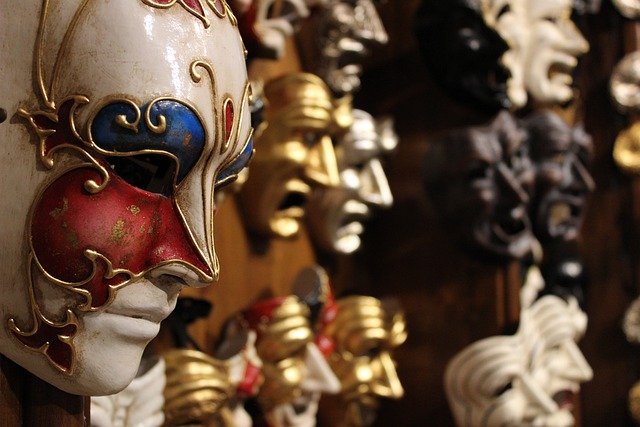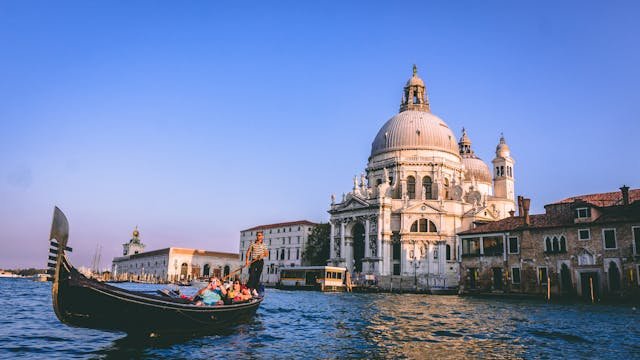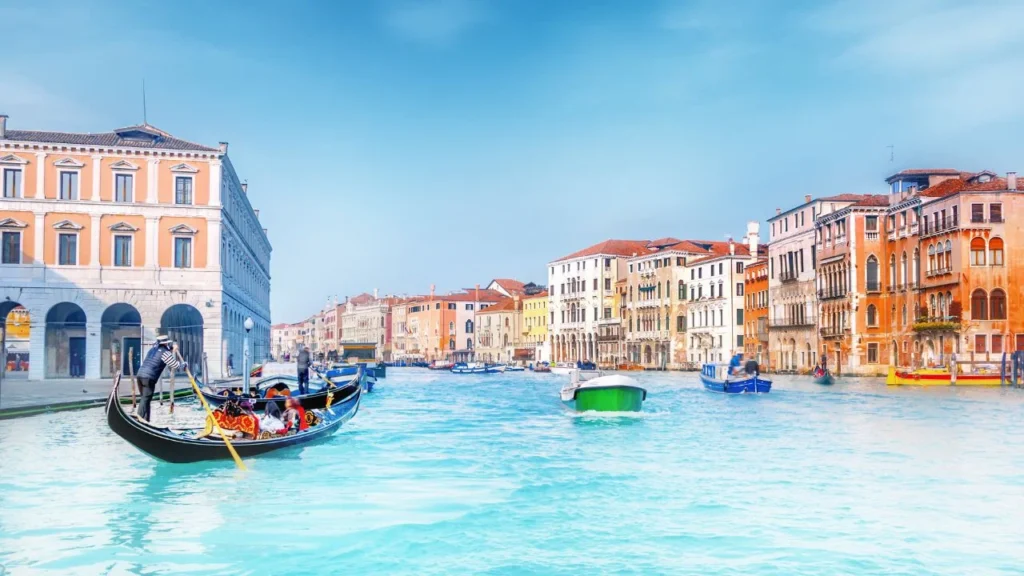- Experiencing Venetian Culture and Traditions
- Join the Famous Venice Carnival
- Admire the Stunning Art and Architecture
- Stroll Through the Rialto Market
- Take a Gondola Ride Through the Canals
- Taste Authentic Venetian Food
- Watch Craftsmen Create Venetian Glass and Lace
- Celebrate Local Festivals
- Visit Hidden Churches and Museums
- Learn Venetian History on a Walking Tour
Experiencing Venetian Culture and Traditions
Experiencing Venetian culture and traditions gives you a mix of history, art, architecture, music, food, and festivals. These things show Venice’s special role as a center of trade, creativity, and art over many centuries. Here’s how I will explain, from my own experience, how you can truly experience Venetian culture and traditions:
Join the Famous Venice Carnival
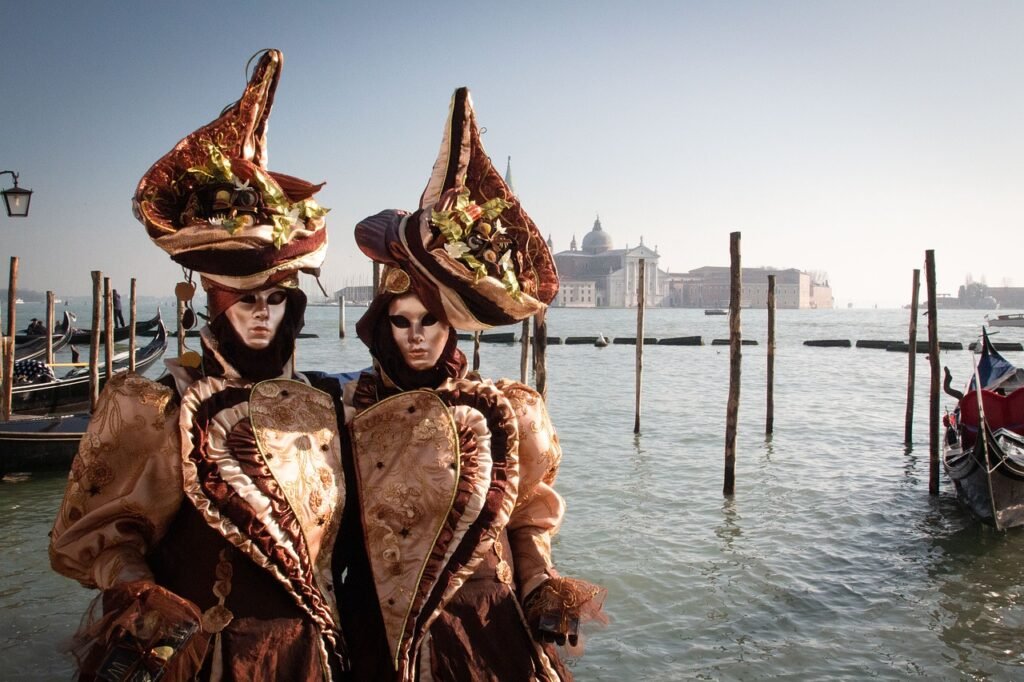
The Venice Carnival is one of the most exciting and colorful events in Europe, with roots going back to the 12th century. The Carnival used to be a time when people from all classes could mix together, with everyone hiding behind intricate masks and costumes. Today, the Carnival is a celebration of Venice’s past, with events like costume contests, historical reenactments, and parades in St. Mark’s Square.
For tourists, participating in the Venice Carnival offers a chance to step into the past. You can rent or buy a traditional Venetian mask and attend a masquerade ball or party. Many local workshops still make masks by hand, using techniques passed down through generations. The Carnival only lasts for a few weeks, so if you’re visiting during this time, it’s a once-in-a-lifetime opportunity to see Venice at its most festive and theatrical.
Admire the Stunning Art and Architecture
Venice’s art and architecture are among the most important in the world, blending Gothic, Byzantine, and Renaissance styles. St. Mark’s Basilica, located in the heart of the city, is one of the best examples of this mix. Its interior is covered in golden mosaics that tell stories from the Bible, and its exterior is richly decorated with sculptures and symbols of Venice’s wealth and power. Tourists can climb up to the terrace for a view of St. Mark’s Square, which is surrounded by historic buildings and the famous Campanile (bell tower).
Beyond St. Mark’s, the Doge’s Palace is another must-see. Once the residence of Venice’s rulers, this palace is filled with grand halls, frescoes, and beautiful artwork. You can walk across the Bridge of Sighs, which once led prisoners from the palace to the city’s jails. For art lovers, the Gallerie dell’Accademia showcases works by some of Venice’s greatest painters, like Titian, Tintoretto, and Veronese.
Stroll Through the Rialto Market
The Rialto Market has been the center of Venetian commerce for centuries. Located near the iconic Rialto Bridge, this bustling market is where locals buy fresh seafood, fruits, vegetables, and spices. It’s an authentic experience for tourists who want to see Venice’s daily life up close. The market opens early in the morning, and it’s best to visit before noon, when the fishermen bring in their catch from the Adriatic Sea.
As you wander through the market, you can see Venetians picking up ingredients for classic dishes like fritto misto (fried seafood) or risotto alla pescatora (seafood risotto). The market is not just for buying food; it’s a lively social space where locals chat and catch up on news. Even if you’re not planning to cook, the vibrant colors and scents of the market make it worth visiting
Take a Gondola Ride Through the Canals
No visit to Venice is complete without a gondola ride. Gondolas have been used in the city for over a thousand years as the main form of transportation through its narrow canals. Today, they are a symbol of Venice’s romantic charm. While the price of a gondola ride may seem high, it’s an unforgettable experience that allows you to see Venice from the water, just as locals did for centuries.
A gondola ride takes you through Venice’s winding canals, under its famous bridges, and past some of its oldest buildings. Your gondolier, who wears a traditional striped shirt and hat, may even sing or tell you stories about the city’s history. If you want a truly magical experience, consider taking a ride at sunset, when the city glows in golden light and the canals become even more enchanting.
Taste Authentic Venetian Food
Venice has a unique cuisine that reflects its history as a trading city. Because Venice was a major port, its food includes ingredients and spices from all over the world. However, seafood plays the biggest role in Venetian dishes, thanks to the city’s location on the lagoon.
When dining in Venice, tourists can start with Cicchetti, small snacks served in local bars known as bacari. These can include marinated Sardines, fried meatballs, and slices of crusty bread topped with fresh seafood. For a main course, try Bigoli in salsa, a thick pasta served with a savory anchovy and onion sauce, or Fegato alla Veneziana, a dish made with tender slices of liver and onions. Every meal should be accompanied by a glass of local wine, like Prosecco or Soave.
Dessert is also an important part of the Venetian experience. Traditional sweets like frittelle, deep-fried dough balls filled with cream or raisins, are especially popular during the Carnival. Venice also has its own version of tiramisu, made with layers of mascarpone and espresso-soaked biscuits.
Watch Craftsmen Create Venetian Glass and Lace
Venetian craftsmanship is world-famous, particularly for glassmaking and lace-making. These ancient arts are still practiced today on the nearby islands of Murano and Burano. Murano glass has been crafted by master glassblowers since the 13th century. You can watch them work in their studios, shaping molten glass into delicate vases, intricate chandeliers, or colorful beads. Visitors can also learn about the history of glassmaking at the Murano Glass Museum.
Meanwhile, the island of Burano is known for its brightly colored houses and its handmade lace. Burano lace has been made by hand since the 16th century, and you can visit lace workshops where women still use traditional techniques to create stunning lacework. The Lace Museum on Burano offers a deeper look into this beautiful and intricate art form. Tourists often take home a piece of Murano glass or Burano lace as a unique and authentic souvenir of their trip.
Celebrate Local Festivals
Venice’s calendar is filled with festivals that reflect the city’s religious, cultural, and artistic traditions. Besides the Venice Carnival, another important event is the Festa del Redentore, which takes place every July. This festival commemorates the end of a devastating plague in the 16th century, and it’s marked by a grand fireworks display over the canals. Venetians celebrate by building temporary bridges across the canals and enjoying food and music with friends and family.
La Biennale is another major event in Venice, especially for art lovers. This international art exhibition takes place every two years and showcases contemporary art, architecture, and film from around the world. It’s a great way for tourists to see Venice’s role as a center of modern culture, alongside its historic past.
Visit Hidden Churches and Museums
Venice is filled with small, often overlooked treasures that offer a quieter and more intimate experience of the city’s culture. While most tourists flock to St. Mark’s Basilica, there are many other beautiful churches worth visiting. For example, Santa Maria della Salute is a stunning Baroque church built in thanks for Venice’s survival during the plague. Its impressive dome is a key part of the city’s skyline.
Another hidden gem is the Scuola Grande di San Rocco, a former confraternity building that now houses an incredible collection of paintings by Tintoretto. This space offers a peaceful atmosphere for admiring Venice’s artistic heritage. Similarly, the Ca’ Rezzonico museum offers a glimpse into the opulent lifestyle of Venice’s aristocrats during the 18th century.
Learn Venetian History on a Walking Tour
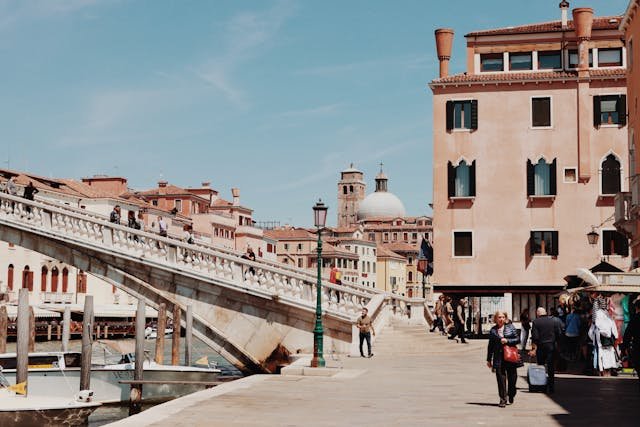
Walking tours offer tourists the chance to hear the stories behind Venice’s most iconic landmarks. Many tours focus on different aspects of Venice’s history, from its role as a powerful maritime republic to its mysterious legends and ghost stories. A tour of the Jewish Ghetto, the first of its kind in Europe, offers insight into the lives of Venice’s Jewish community, who were confined to the area for centuries but contributed greatly to the city’s culture.
Exploring Venice on foot is one of the best ways to experience its unique layout. The city’s narrow streets, hidden alleyways, and countless bridges are full of surprises, from quiet courtyards to small art galleries. A local guide can bring the city’s past to life with stories about the people who lived there, from wealthy merchants to famous artists.
Experiencing Venetian culture is like stepping into a living painting, where every corner tells a story. The blend of history, art, and everyday life creates a unique atmosphere that captivates visitors. From the stunning architecture of the canals to the delicious flavors of local cuisine, Venice offers a rich tapestry of experiences. Engaging with the friendly locals, exploring vibrant markets, and enjoying traditional festivals can make you feel like part of this enchanting city. Ultimately, immersing yourself in Venetian culture is a journey filled with beauty, warmth, and unforgettable memories.

